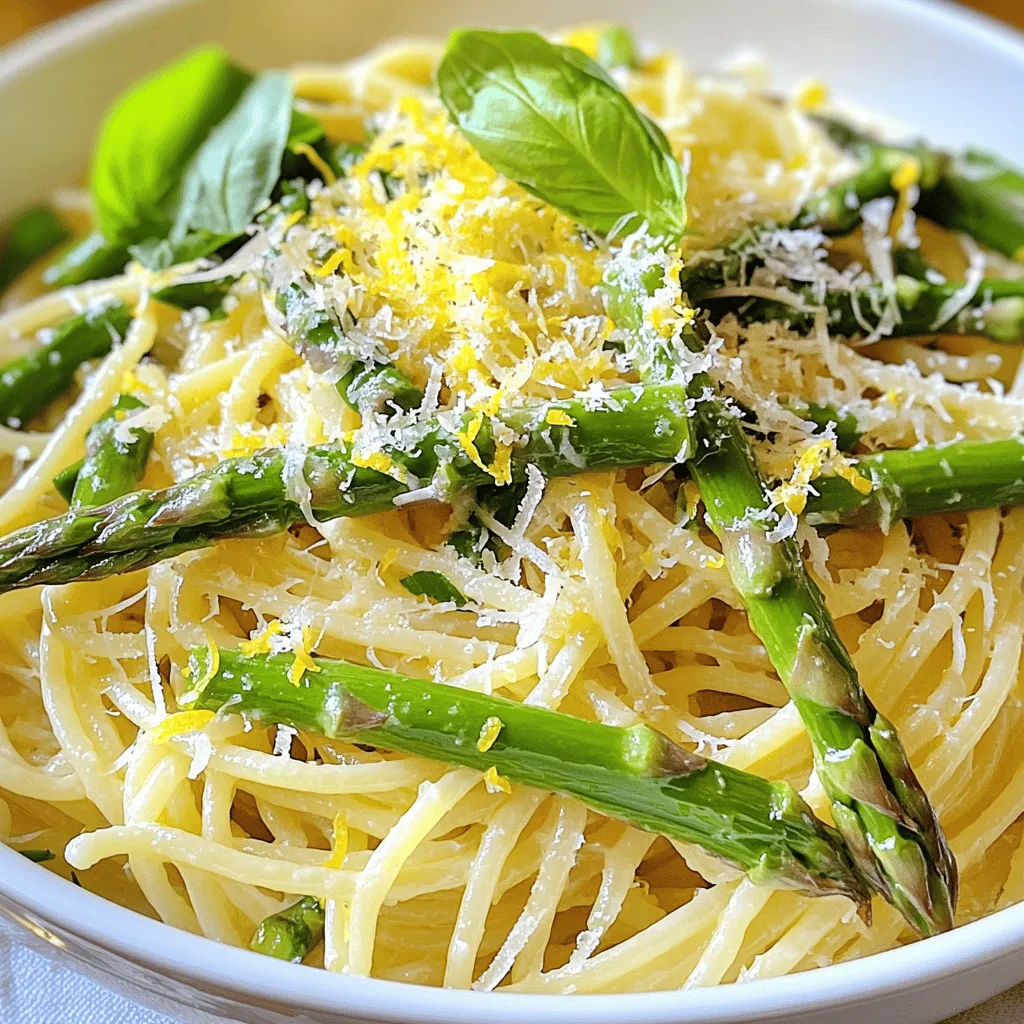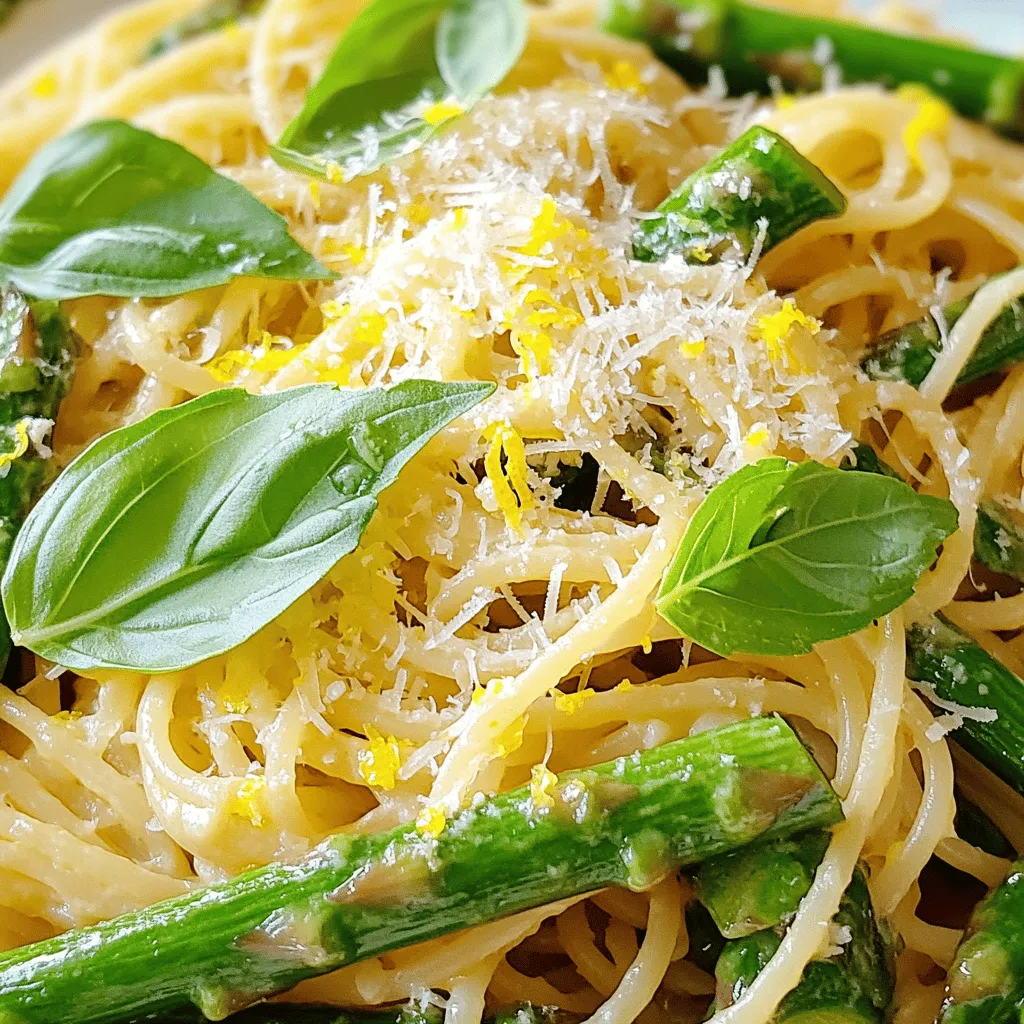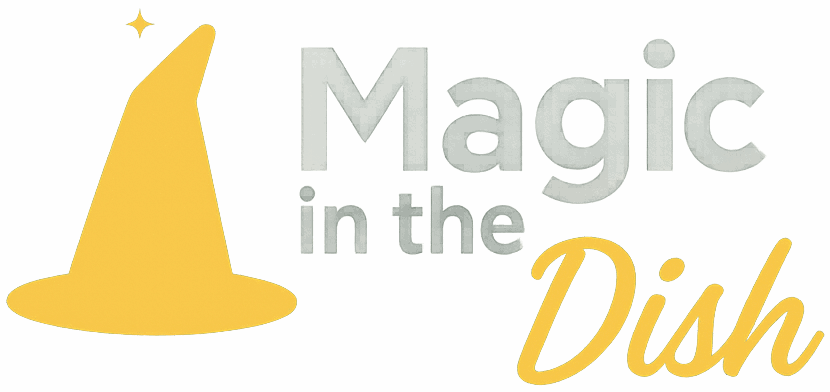Looking for a quick, fresh meal? Lemon Garlic Asparagus Pasta is your answer. This tasty dish bursts with flavor and is simple to make. You only need a few key ingredients like asparagus, garlic, and lemon. Whether you’re cooking for yourself or impressing guests, this recipe is easy to follow and delicious. Let’s dive into the ingredients and get started on this vibrant pasta dish!

Ingredients
Main Ingredients
– 8 oz spaghetti or fettuccine
– 1 bunch fresh asparagus, trimmed and cut into 2-inch pieces
– 4 cloves garlic, finely minced
– 3 tablespoons extra virgin olive oil
Flavor Enhancers
– Zest of 1 fresh lemon
– Juice of 1 fresh lemon
– 1/4 teaspoon red pepper flakes (optional)
– Sea salt and black pepper to taste
Optional Ingredients
– 1/2 cup freshly grated Parmesan cheese or dairy-free alternative
– Fresh basil leaves, torn for garnish
The main ingredients here are simple yet flavorful. Spaghetti or fettuccine serves as the base. Fresh asparagus adds crunch and nutrients. Garlic brings depth, while olive oil ties it all together.
For flavor enhancers, lemon zest and juice give a bright kick. Red pepper flakes can add a touch of heat, but they are optional. Use sea salt and black pepper to taste. These ingredients balance each other well.
Optional ingredients like Parmesan cheese can make the dish richer. You can also use a dairy-free alternative if you prefer. Fresh basil adds a lovely touch and a pop of color.
Gathering these ingredients makes cooking easy and fun. You’ll find that they blend well together for a delightful meal.
Step-by-Step Instructions
Preparing the Pasta
– Bring a large pot of salted water to a rolling boil.
– Add 8 oz of spaghetti or fettuccine to the pot.
– Cook the pasta until it is al dente, which means it should be firm but not hard.
– Reserve 1 cup of the pasta water before draining the rest.
– Drain the pasta and set it aside for later.
Sautéing the Asparagus
– While the pasta cooks, heat 2 tablespoons of olive oil in a large skillet over medium heat.
– Wait until the oil shimmers, then add the asparagus pieces.
– Sauté the asparagus for about 4-5 minutes. Stir occasionally to cook evenly.
– The asparagus should be tender but still bright green when done.
Combining Ingredients
– Add minced garlic and optional red pepper flakes to the skillet.
– Sauté for 1-2 minutes until the garlic smells great and turns light golden.
– Lower the heat to medium-low and add the drained pasta to the skillet.
– Mix in lemon zest, lemon juice, and the last tablespoon of olive oil.
– Toss everything together, adding reserved pasta water slowly until you reach your desired sauce thickness.
– Season with sea salt and black pepper, then mix in half of the grated Parmesan cheese.
– Serve hot, garnished with more Parmesan and fresh basil leaves for extra flavor.
Tips & Tricks
Perfecting the Pasta
To get the perfect al dente texture, cook the pasta until it is firm yet tender. Follow the package instructions carefully. Remember, the pasta will keep cooking after you drain it. So, stop cooking just before it’s fully done. This way, it stays firm when mixed with the sauce.
When you drain the pasta, save some of the pasta water. This water is starchy and helps create a creamy sauce. Reserve at least one cup before draining. You can add it later if the dish seems dry.
Sautéing Tips
For sautéing, heat the oil on medium heat until it shimmers. This means the oil is hot enough. If the oil is cold, the asparagus won’t cook well. You want it to be bright green and crisp.
To avoid burning garlic, add it after the asparagus. Garlic cooks fast, so stir it in for just one to two minutes. Watch it closely. Once it turns golden, it’s perfect. If it burns, it can taste bitter.
Flavor Customization
You can adjust the lemon flavor to your taste. If you want a stronger lemon kick, add more zest or juice. Start with a little, then taste and add more if you like.
For a vegan option, swap the Parmesan cheese for a dairy-free alternative. Nutritional yeast also adds a cheesy flavor without dairy. You can find many great vegan cheeses at the store. Choose one that you enjoy!

Variations
Protein Additions
You can easily boost your Lemon Garlic Asparagus Pasta with protein. Grilled chicken or shrimp adds a nice touch. Just cook them separately, then toss them in with the pasta. For a vegan option, consider using tofu or chickpeas. Tofu absorbs flavors well and chickpeas offer a hearty texture.
Vegetable Variations
Feel free to mix in other seasonal vegetables. Bell peppers, cherry tomatoes, or zucchini work great. If you want to switch things up, try using green beans instead of asparagus. They add a nice crunch and vibrant color. Just sauté them for about the same time as the asparagus.
Spicy Twist
If you like some heat, add more spices. A pinch of cayenne pepper or some diced jalapeños can elevate the dish. You can also make this a one-pot meal. Just cook the pasta and veggies together in the same pot. This saves time and makes cleanup a breeze!
Storage Info
Storing Leftovers
To store your Lemon Garlic Asparagus Pasta, place it in an airtight container. This helps keep the flavors fresh. I recommend refrigerating it within two hours of making it. It can last for up to three days. To keep pasta fresh longer, avoid adding the cheese until you’re ready to eat. The cheese can get soggy in the fridge.
Reheating Tips
You can reheat leftover pasta in two ways: the microwave or the stove. If using the microwave, cover the pasta with a damp paper towel. This helps it stay moist. Heat it in short bursts, stirring in between. If you prefer the stove, heat a skillet over low heat. Add a splash of water or olive oil to prevent sticking. Stir often to keep the pasta from getting soggy.
Freezing Instructions
If you want to freeze the pasta, let it cool completely first. Then, portion it into freezer-safe bags. Squeeze out as much air as you can. This helps prevent freezer burn. The pasta can stay frozen for up to three months. To defrost, place it in the fridge overnight. For a quicker method, use the microwave on the defrost setting. After thawing, reheat it on the stove with a splash of water or oil.
FAQs
How can I make Lemon Garlic Asparagus Pasta gluten-free?
You can use gluten-free pasta options. Look for brands like brown rice or quinoa pasta. They work well and taste great. Just cook them according to the package directions. This way, you enjoy the same tasty dish without gluten.
Can I use frozen asparagus?
Yes, you can use frozen asparagus. Frozen asparagus is often picked at its peak. However, fresh asparagus gives a crisp texture. Frozen may be softer when cooked. If you choose frozen, skip the thawing step. Just add it directly to the skillet.
What can I serve with this dish?
You can serve Lemon Garlic Asparagus Pasta with various sides. A simple green salad pairs well. Garlic bread adds extra flavor and warmth. Grilled chicken or shrimp can also make it heartier. For a light touch, serve with lemon wedges.
This blog post covered how to make Lemon Garlic Asparagus Pasta. We discussed key ingredients, step-by-step cooking, and handy tips. You can customize the dish with proteins and veggies. Proper storage and reheating keep your leftovers fresh.
By following these steps, you can create a tasty meal that fits your taste. Enjoy experimenting with flavors and make it your own!

